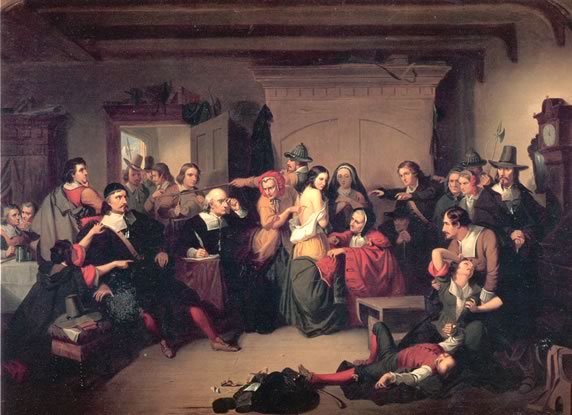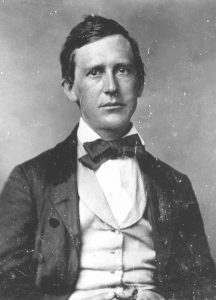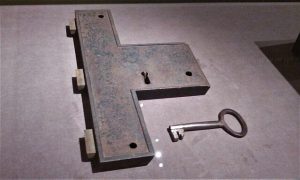Why would adults in Salem, Massachusetts in the 1690s take the accusations of nine year old girls seriously? During the seventeenth century, New England had grown diverse. The people living in the communities were of different backgrounds. But in the 1690’s there was an apparent outbreak of witchcraft. The most famous of these outbreaks was the event in Salem, Massachusetts in 1692 that stirred up the Salem community and soon spread to other communities.
The widespread hysteria over witches was all over the town after an accusation of witchcraft was made in January 1692. A group of young adolescent girls met in the home of Samuel Parris, a Puritan pastor in Salem. The pastor had a nine year old daughter, Betty. Betty and her cousin Abigail were fascinated by the voodoo tales and tricks told to them by the family slave. The family slave, Tituba, was the one whom the little girls had sought after for entertainment.1 It was not long after their time spent with Tituba, when the girls began to behave strangely; seeing visions, babbling at times, and lapsing into trances. The Puritans thought that these behaviors were of witchcraft, as the work of the devil. People in Salem began believing the girls, and charged Tituba and two other village women for practicing witchcraft on them. Two men, John Hathorne and Johnathan Corwin of Massachusetts, were called to do a legal examination of the women. The Puritans followed the Old Testament law. This was how they assessed the examinations. Scripture had a statement that said witches were not able to live. The two men knew exactly what they had to do. The examination was done on these women of Salem by looking for a certain mark on the body: a wart or tit. This specific mark was said to be the place where the devil and his demons would take blood out of the witch.2 Many of the women accused were of lower status in the community.

Research shows most of the accused witches were middle-aged women, widowed, with few or no children. Also, if the woman had been involved with domestic conflicts, they were accused. The women were accused of crimes and appeared to be dangerous by their neighbors. Women in Salem who inherited or possessed land were also accused of witchcraft.3 The accusations towards these women were out of the ordinary and seemingly wrong. One must first think about the view of women during this time. They were undermined and portrayed as having no power or knowledge of such things; they were subservient to the men in the community. Not only were low class women accused of witchcraft, but as time passed, superior women were accused as well.4
On October 29th, the Salem Witch Trials were called to an end. Governor Phips dismissed the Court and that marked the end to the witch hunt craze. Many were disappointed about the ending of the trials, but many were glad to return to work.5 The community in Salem blamed Pastor Parris for letting the innocent die. The people of the Salem church also voted to void his salary. In the following years, those family members of the deceased were restored their good names. The families were awarded a compensation for all the financial loses they went through during such tragic times. Increase Mather, a pastor of the Boston Puritan Church, wanted the people to do away with the court because he believed they put innocent people to death.
The Witch trials took on an important role in American History. The trials became a tragic and memorable moment in history. Generational, racial, and sexual hostility, opposition to law, social stresses, and food poisoning were all causes as to why the people had anxieties that found release in the witch hunt craze. The witch hunts became searches for scapegoats; the community leaders were looking for anyway possible to ease the community’s anxieties.6
- Kenneth P. Minkema, “In the Devil’s Snare: The Salem Witchcraft Crisis of 1692,” The Christian Century, no. 8 (2003): 37. ↵
- Salem Press Encyclopedia, January 2015, s.v. “Salem Witchcraft Trials,” by Warren M. Billings and Kimberly Manning. ↵
- Alan Brinkley, American History, 15th ed., vol. 1: to 1865 (2 Penn Plaza, New York, NY 10121: McGraw Hill Education, 2015), 86-87. ↵
- Salem Press Encyclopedia, January 2015 s.v. “Salem Witchcraft Trials,” by Warren M. Billings, Kimberly Manning. ↵
- Salem Press Encyclopedia, January 2015 s.v. “Salem Witchcraft Trials,” by Warren M. Billings, Kimberly Manning. ↵
- Salem Press Encyclopedia, January 2015 s.v. “Salem Witchcraft Trials,” by Warren M. Billings and Kimberly Manning. ↵



178 comments
Angelo Oliva-Noeggerath
The pictures used in the article help bring out the message of the events that are occurring in the article. The witch trials of Salem is a bad event that occurred but seeing the pictures provided with the article, it allows for the reader to see how the events transpired or how the gatherings looked. The detailed information regarding the events that occurred in Salem as well helps show the things that went on other than the major facts known about the witch trials of Salem and it allowed the reader to know more about the intricate details that were occurring.
Edgar Cruz
I think, overall, that the use of the sources was very effective and adequate. The questions posed at the beginning made me really think about the motives and origins of the story I was about to read and really made me more invested. I think the narrative writing style is very effective, as well.
Ariette Aragon
I found this article really fascinating and interesting, especially the question you introduced us with, it really caught my attention and made me think about what those tragic times. Moreover, I want to mention that the pictures used throughout the reading gave me a clear idea of what these women were put through during the trials. I think the themes about sexism and just discrimination overall, that are covered in the article are still important nowadays. Sadly, in our society there is still a sexist mindset among a lot of people, and thinking that this topic is still of relevance to these modern days is very heartbreaking to me, as a woman.
Matthew Tobar
First of all, let me say that this was a fantastic article, good job! Fun fact – since the Commonwealth of Massachusetts is still the state government, back in 1957, the state government officially apologized for the Salem Witch Trials, however, it wasn’t until 2011 that the last of the victims were exonerated. I like how you point out that these trials were indeed sexist in nature, especially how they were initially discriminatory towards lower-class women. I remember reading The Crucible junior year of high school, so it was a nice change of pace to see the Trials presented from a different, younger perspective. I can’t even begin to imagine what these women had going through their minds during this time, it’s truly scary to think about.
Phylisha Liscano
Hello Oscar, I wanted to say you wrote an excellent article. You kept things short and straight to point, allowing my mind not to wonder off. First off taking a look at your citations I can see you did lots of research to compose this article and that’s very good. You’re introduction drew me in with your questions about why adults would trust nine year old girls. Before now I did not know so much about this topic but reading your article allowed me to get an understanding of how it started and ended. One last thing great touch with the pictures.
Marycarmen Sanchez
The Salem Witch Trials are among the most interesting things to read about in American history. But, it sounds like a horrific time to be living in especially if no one liked you. This article just showed why the amendments were very much needed during those times, it is also a show of why it is very important to separate religion and politics. I enjoyed reading this article, it was brief and kept to the topic without straying off into something else. You didn’t romanticize anything, and divided everything very well into great paragraphs.
Tyler Pauly
Although I have already heard of this story before, no matter how many times I read it it never ceases to amaze me that people believed in witches and were able to execute people based on minuscule proof. It just goes to show you how drastic values and beliefs can change within society over time. I hadn’t, however, heard that the families of those that were wrongly accused were given compensation. I wonder what the reaction to this at the time was.
Travis Green
First off I got to say great article. It was easy to follow and understand the message throughout reading. It’s weird to think about the trials now with a modern lens because a lot of the things that happened were really just because of general ignorance. Like most of the accused being women particularly middle aged women with no children being a good example.
Samuel Vega
This article was very informative. The images selected related well to the article. From the color image, you can see how women were degraded not just by the accusations of being a witch; but their bodies exposed to show the mark of the devil. It would have been unheard of for women to show any part of their bodies, yet they were forced in a court with men and other women watching.
Jourdan Carrera
The enjoyed this article, primarily because it is one of a very interesting topic to me. The late English colonial period of the 1600’s has always been one of fascination to me as the area around that part of North America still remained dark and mysterious even though the English had been there for almost 100 years. I also particularly enjoy this article as around 3-4 years ago I read a historical fiction book titled ‘I, Tituba: Black Witch of Salem’. In this book the author examines the life of Tituba and how she lived and what her thoughts were while being in the ownership of Samuel Parris and his family. This article brought back the fond memory of that book as well as allowed me to read about something I find enjoyable, especially since Halloween is coming soon.